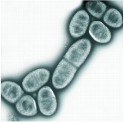Gluconobacter oxydans: Difference between revisions
No edit summary |
No edit summary |
||
| Line 17: | Line 17: | ||
==Description and significance== | ==Description and significance== | ||
[[Image:Pic.jpg|frame|right| | [[Image:Pic.jpg|frame|right|© PD Dr. M. Hoppert, Georg-August-Universität, Göttingen]] | ||
Describe the appearance, habitat, etc. of the organism, and why it is important enough to have its genome sequenced. Describe how and where it was isolated. | Describe the appearance, habitat, etc. of the organism, and why it is important enough to have its genome sequenced. Describe how and where it was isolated. | ||
Include a picture or two (with sources) if you can find them. | Include a picture or two (with sources) if you can find them. | ||
Revision as of 08:19, 3 May 2007
A Microbial Biorealm page on the genus Gluconobacter oxydans
Classification
Higher order taxa
Domain: Bacteria; Phylum: Proteobacteria; Class: Alphaproteobacteria; Order: Rhodospirillales; Family: Acetobacteraceae; Genus: Gluconobacter; Species: oxydans [Others may be used. Use NCBI link to find]
Species
|
NCBI: Taxonomy |
oxydans
Description and significance
Describe the appearance, habitat, etc. of the organism, and why it is important enough to have its genome sequenced. Describe how and where it was isolated. Include a picture or two (with sources) if you can find them. Gluconobacter oxydans, previously known as Acetobacter suboxydans, are Gram-negative rod or oval shaped bacterium ranging from about 0.5 to 0.8mm x to 4.2mm. They tend to have a small genome size because of their limited metabolic abilities. These abilites include partially oxidizing carbohydrates and alcohols through the process of oxidative fermentation, and they can be used for sythesis of Vitamin C, D-gluconis acid and ketogluconic acids. G. oxydans are found in flowers, fruits, garden soil, alcoholic beverages, cider, and soft drinks because they are capable of growing strains in high concentrations of sugar solutions and low pH values (optimal pH for growth is 5.5-6.0.) Although they are able to grow in extreme conditions, its growth rate is slow and the concentration of mature cells are low. The importance of G. oxydan is its ability to incompletely oxidize carbon substrates such as D-sorbitol, glycerol, D-fructose, and D-glucose for the use in biotechnological instruments.
Genome structure
Describe the size and content of the genome. How many chromosomes? Circular or linear? Other interesting features? What is known about its sequence? Does it have any plasmids? Are they important to the organism's lifestyle?
The genome of Gluconobacter oxydans tend to be small in size, ranging about 2240 to 3787kb (Verma et al., 1997). Shapes can be ellipsoidal or rod-shaped with dimensions of 0.5 to 0.8x0.9 to 4.2mm.
Cell structure and metabolism
Describe any interesting features and/or cell structures; how it gains energy; what important molecules it produces.
Ecology
Describe any interactions with other organisms (included eukaryotes), contributions to the environment, effect on environment, etc.
Pathology
How does this organism cause disease? Human, animal, plant hosts? Virulence factors, as well as patient symptoms.
Application to Biotechnology
Does this organism produce any useful compounds or enzymes? What are they and how are they used?
Current Research
Enter summaries of the most recent research here--at least three required
References
Edited by student of Lynn S Cheung and Kit Pogliano

